 |
Tridachia diomedea
Picture taken at Sal Se Puertes Is. in the Midriff Is. group 100+ miles north of San Carlos, Sea of Cortez by Jerry Allen of Tucson, Az.
Tridachia diomedea ( Bergh, 1894)
a.k.a. Elysia diomedea (Bergh, 1894)
FIRST SIGHTING
The original type specimens of Tridachia diomedea were dredged from 10 fathoms between Punta Gorda and the southwest corner of Isla Cerralvo (24 11' N; 109 55' W) on 30 April 1888. Bergh (1894: 194) states that these animals were collected "von Pleurophyllidia californica und Chromodoris californiensis" (species we recognize today as Armina californica and, from this location, Hypselodoris ghiselini ). However, elsewhere in this manuscript, Bergh (1894: 181 and 197) indicates Pleurobranchus plumula was collected rather than Pleurophyllidia; on page 154 he states the collection locality of the arminid as 24 18' N; 110 22' W, a different site than described for Tridachia diomedea. This was not the only instance of mixed lots by Dr. Bergh.
DESCRIPTION
Tridachia diomedea has frilled parapodial lobes; the body varies from light green to almost black, with longitudinal black and yellow lines or streaks on the rhinophores and light yellow or whitish lines on the sides of the body. Often there is a peppering effect of orange and black splashes on the edges of the parapodia. Animals typically range from 30-50 mm, although large individuals are not uncommon.
BIOLOGY
Since its original description, we have discovered numerous intriguing biological aspects about this species. The animals' bodies harbor endosymbiotic algal chloroplasts which contribute photosynthetic products to the host slug (see Greene, 1969, for an early summary of this research). The most recent discussion of the feeding of Tridachia diomedea and the photosynthetic capabilities of its endosymbiotic chloroplasts is by Cimino & Ghiselin (1998), where they brilliantly analyze the much larger problem of chemical defense and evolution within the Sacoglossa.
BIOGEOGRAPHY
This species is known to occur throughout the Gulf of California to Panama; it has not been reported from the Pacific coast of the Baja California peninsula. Tridachia diomedea is one of the most common opisthobranch species in the Gulf of California. For example, during a three-year period of research (18 January 1992-15 January 1995) at Bahía de los Angeles, I identified and measured 3056 opisthobranch specimens. Of these, 1275 individuals (or 41.7% of all opisthobranch organisms recorded) were Tridachia diomedea (Bertsch, 1995).
WHAT DO WE CALL IT?
Ah, yes, what is in a name? If it's yours, everything. If it's biological, we hope it is monophyletic!
Bergh named this species in the genus Tridachia, shared also with its sister Caribbean speciesT. crispata. The species crispata and diomedea allopatrically speciated from a common ancester with the closure of the Central American/Panamanian seaway. In 1924 MacFarland named the new monotypic genus Tridachiella to accommodate T. diomedea. Two species, two genera; both from a common ancestor. This is obviously an unnecessary division of supraspecific taxa.
My good friend and colleague Dr. Terrence Gosliner (1995) published a careful and thoughtful phylogenetic analysis of the Elysiidae sacoglossans. He analyzed the plesiomorphic and apomorphic conditions of a dozen character states, concluding that Tridachiella, Tridachia, Elysiella and Pattyclaya are "synonyms of Elysia, as this is the oldest name for the most inclusive monophyletic group. Elysia represents a large and morphologically diverse taxon. Further phylogenetic analysis of this taxon is needed to ascertain whether monophyletic subclades do in fact exist." His last quoted sentence is especially important in view of his earlier admission (these references are all on page 45 of his opus magnum) that within the clade containing Elysia, Elysiella, Pattyclaya, Tridachia and Tridachiella "there is little resolution of phylogeny."
So for the time being, until clearer resolution is available, I opt to place the sister species crispata and diomedea in the single, distinct genus Tridachia, demonstrating their differences in evolutionary lineages from the other Elysiidae. Terry opts to combine them into Elysia. Regardless of this difference of opinion, we agree that Tridachiella is certainly unnecessary, inappropriate and phylogenetically confusing.
The next time you are scuba diving in the Gulf of California, prepare your camera to photograph this splendidly beautiful species.
Bergh, L.S.R. 1894. Reports on the dredging operations off the west coast of Central America to the Galapagos, etc. Bull. Mus. Comp. Zool. Harvard College 25 (10): 125-233.
Bertsch, Hans. 1995. A three-year phenological analysis of subtidal populations of opisthobranch molluscs at Bahía de los Angeles, Baja California, Mexico. Proc. Pac. Div. Amer. Assoc. Adv. Sci 14 (1): 34.
Cimino, G., and M.T. Ghiselin. 1998. Chemical defense and evolution in the Sacoglossa (Mollusca: Gastropoda: Opisthobranchia). Chemoecology 8: 51-60.
Gosliner, T.M. 1995. The genus Thuridilla (Opisthobranchia: Elysiidae) from the tropical Indo-Pacific, with a revision of the phylogeny and systematics of the Elysiidae. Proc. Calif. Acad. Sci. 49 (1): 1-54.
Greene, R.W. 1969. Symbiosis in sacoglossan opisthobranchs. Univ. Calif. L.A., Ph.D. Dissertation. 120 pp. MacFarland, F.M. 1924. Expedition of the California Academy of Sciences to the Gulf of California in 1921. Opisthobranchiate Mollusca. Proc. Calif. Acad. Sci 13 (25): 389-420.
Text by Dr. Hans Bertsch. Tridachia diomedea photograph courtesy of Jerry Allen, Tucson, Arizona

Assoc. Prof. |
